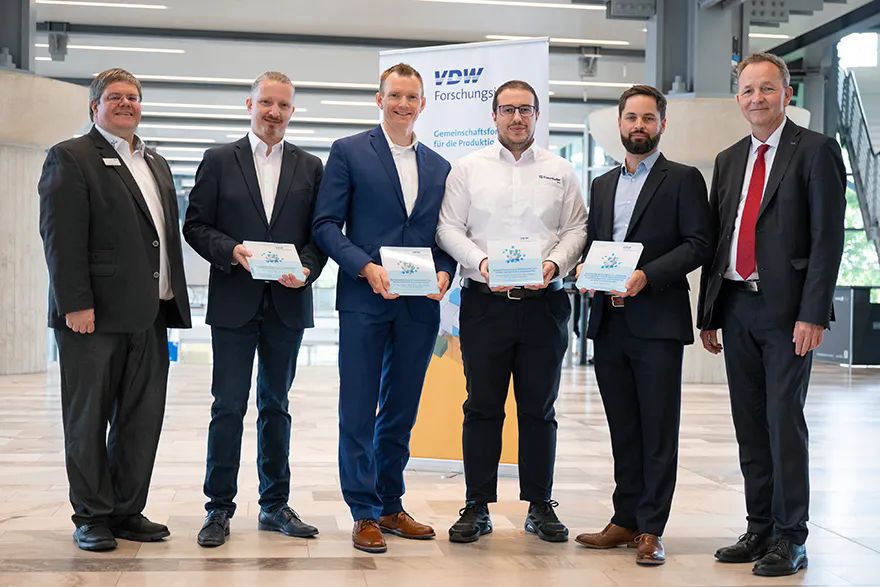 Award ceremony for the VDWFI ‘Project of the Year’ at the EMO Hannover 2025. From left to right: Dr Alexander Broos, Dr Robert Tehel, Nico Wagner, Martin Wagner, Simon Thom, Dr Stephan Kohlsmann. Photo: VDW / Rainer Jensen
Award ceremony for the VDWFI ‘Project of the Year’ at the EMO Hannover 2025. From left to right: Dr Alexander Broos, Dr Robert Tehel, Nico Wagner, Martin Wagner, Simon Thom, Dr Stephan Kohlsmann. Photo: VDW / Rainer JensenAt this year’s
EMO Hannover, the
VDW Research Institute once again celebrated excellence in applied research by awarding its ‘Projects of the Year’ distinction to two outstanding initiatives that are helping shape the future of production technology.
The awards were presented by Dr Stephan Kohlsmann, chairman of the executive board of VDW-Forschungsinstitut e.V., and CEO Dr Alexander Broos. Dr Broos explained the motivation behind the non-monetary prize: “With these awards, we want to specifically recognise the scientific staff of the research institutions involved in these kinds of project, as they generally dedicate themselves to the work for two or three years and achieve some amazing results.”
The 2024 award went to a team from the Fraunhofer Institute for Machine Tools and Forming Technology (IWU) in Chemnitz for their project titled ‘Minimising set-up times on forging hammers using a sensitive die clamping system (sGs).’ Researchers Martin Wagner, Nico Wagner and Dr Robert developed a novel measuring system that records the clamping situation both qualitatively and quantitatively during the forging process. This data enabled FEM simulations that revealed new insights into clamping conditions, ultimately leading to the creation of a new clamping system capable of withstanding the extreme dynamic and thermal loads typical of forging operations.
New possibilities for automationMartin Wagner said: “With the newly developed measuring and clamping concept, companies can make their forging processes safer, more efficient and more economical. The data we obtained provides detailed insights into the actual clamping conditions for the first time and opens up new possibilities for automation.”
The new system offers several advantages, including reduced set-up times due to fewer readjustments, improved process reliability through reproducible pretensioning, and enhanced safety by eliminating uncontrolled hammer blows during wedge driving. The concept also lays the groundwork for future automation and cost reduction.
Sebastian Frank, head of development at Lasco Umformtechnik GmbH in Coburg, supported the project as an industrial partner. He said: “Tool mounting on forging hammers has remained essentially unchanged since the beginning of forging. It was therefore high time to investigate whether new technological methods could be used to gain knowledge that could be developed into practically applicable results, which would allow the highly efficient forging hammer to continue to meet ever more demanding customer requirements. Thanks to its strong practical focus, the project has been able to lay a foundation for the development of future systems.”
The 2023 award was presented to Simon Thom of the Institute of Machine Tools and Factory Management (IWF) at the Technical University of Berlin for his work on the ‘Dimensioning of protective devices for stationary grinding machines.’ The project tackled the challenge of designing protective enclosures that are both effective and space-efficient. Traditional burst testing methods, while realistic, were found to be neither reproducible nor economical. Thom’s approach combined translational impact tests with finite element simulations to develop a regression model that links grinding wheel parameters with the required wall thickness of protective devices.
Highly focused scientific workMr Thom said: “The project is an example of the sustained and highly focused scientific work that is carried out at the IMF. In close cooperation with the machine tool manufacturers in the VDW and the BGHM trade association, we have carried out applied research that directly benefits practical applications.”
The results of the project have already been incorporated into the international standard ISO 16089, simplifying CE marking for manufacturers, accelerating approval processes, and improving workplace safety.
Christian Adler of the Berufsgenossenschaft Holz und Metall, and chairman of the relevant standardisation group, praised the project’s contribution: “As a trade association, our focus is on ensuring that occupational health and safety requirements are not only complied with, but also widely accepted. A sound scientific basis is essential for this. In this context, Mr Thom’s outstanding project has made a significant contribution to the further development of dimensioning specifications for protective devices.”
Both projects were funded by the German Federal Ministry for Economic Affairs and Energy under the ‘Industrial Collective Research’ programme, underscoring the importance of collaborative innovation in advancing industrial standards and safety.